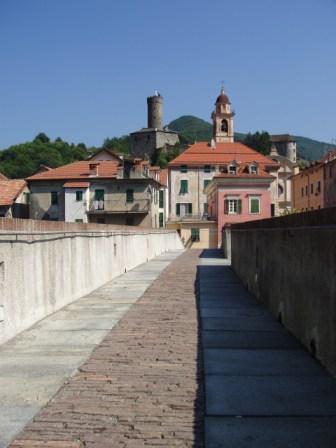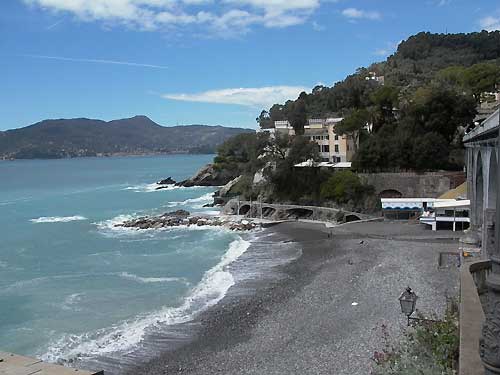Embroidered Gold: the Filigree of Campo Ligure
 Campo Ligure is on the list of The Most Beautiful Towns of Italy and is also the gateway to the UNESCO GeoPark of the Beigua. Since the Middle Ages, its imposing Castello Spinola, with its massive hexagonal stone walls and soaring towers, has kept vigil over the town and the valley. The noble Spinola family also built its magnificent palace here. With its façade entirely covered with frescos, it embellishes Piazza Vittorio Emanuele II, at the heart of the town. On this piazza is also the Church Natività di Maria Vergine with a painting by Bernardo Strozzi, who is considered to be among the most important (and prolific) artists of Italian baroque.
Campo Ligure is on the list of The Most Beautiful Towns of Italy and is also the gateway to the UNESCO GeoPark of the Beigua. Since the Middle Ages, its imposing Castello Spinola, with its massive hexagonal stone walls and soaring towers, has kept vigil over the town and the valley. The noble Spinola family also built its magnificent palace here. With its façade entirely covered with frescos, it embellishes Piazza Vittorio Emanuele II, at the heart of the town. On this piazza is also the Church Natività di Maria Vergine with a painting by Bernardo Strozzi, who is considered to be among the most important (and prolific) artists of Italian baroque.
The art of filigree, the magical weaving of slender threads of gold and silver, was born in the Middle East, and was soon (two thousand years ago) adopted by the Etruscans. But it was the crusades that brought the art to Genoa. It became a local excellence in the 1800s thanks to the works of Antonio Oliveri who opened a workshop in Campo Ligure which then became the “school” for the whole of Italy. Still today artisan craftsmen work metal filigree in Campo Ligure with the same instruments and ancient techniques used in the past, to make elegant jewels that are out of time.
While in Campo Ligure, make a stop to taste the "revzöra", a focaccia made from corn meal. And in autumn, don’t miss the "bazzurra" a soup made from milk and chestnuts.
Val Fontanabuona: Black Slate, Red Damask
From the west of the Genoese hinterlands, we move east towards the valley of slate, the Val Fontanabuona. The landscape of the valleys of the Apennine Mountains on this side of Genoa is green and verdant. They open onto the coast at the Gulf of Paradise and the Gulf of Tigulllio; these two Riviera gulfs being divided by the promontory (and Regional Park) of Portofino. Centuries-old footpaths lead down from the valley to the coast, with views that are breath-taking.
The Val Fontanabuona is filled with slate quarries. The slate, black and shiny, sturdy but soft to carve and cut, has been used since time immemorial for roofing, stairs, lintels, and architectural decoration such as capitals. This was the home of Christopher Columbus’ ancestors, and was also a crossroads on the Salt Road (which sent sea salt to northern Italy).
Also in Val Fontanabuona is Lorsica. This little village in the Apennine Mountains first came to Europe’s notice in the 1500s because of its production of damasks, brocades, and lampas (a type of brocaded taffeta). These luxury fabrics are still woven today on the same looms that produced the dresses and the upholstery fabrics for Renaissance courts across Europe. Production is done both by hand, and by the use of extremely sophisticated machinery that maintains the high quality but gives the quantity necessary for foreign markets, especially New York.
Velvet on the Sea in Zoagli
 From Lorsica we head back to the sea, past the beautiful Riviera towns of Portofino and Santa Margherita, and on to Rapallo on a bay shaped like a half moon. Next along the coast comes Zoagli, which though an ancient pre-Roman settlement, is more famous for its luxurious velvets. Still made by hand on antique looms using shuttles and bobbins, its velvets are an intrinsic part of European history, as seen in the portraits of nobles painted by Van Dyck. The shine of black velvets from Zoagli was seen in all the refined courts of Europe.
From Lorsica we head back to the sea, past the beautiful Riviera towns of Portofino and Santa Margherita, and on to Rapallo on a bay shaped like a half moon. Next along the coast comes Zoagli, which though an ancient pre-Roman settlement, is more famous for its luxurious velvets. Still made by hand on antique looms using shuttles and bobbins, its velvets are an intrinsic part of European history, as seen in the portraits of nobles painted by Van Dyck. The shine of black velvets from Zoagli was seen in all the refined courts of Europe.
Also dating to the 1500s are the watchtowers that were built to protect Zoagli from the legendary pirate, Dragut. A path called the Five Watchtowers, “Cinque Campanili”, connects them together with to the outlying portions of the town, passing through narrow alleyways, across ancient mule paths and nature trails cutting through the greenery of the hill of Zoagli above the sea.
In the summer here you can swim in crystal clear waters in the small coves and sandy bights, or dive 9 meters under the waves to pay homage to the Madonna del Mare sculpture created by artist, Marian Hastianatte. The sea promenade is lovely in all seasons, with tiny beaches interspersed among the boulders. A picturesque walk that equals that of the Cinque Terre.
The Lightest Chairs in the World Are Made in Chiavari
Next after Zoagli on the coast is Chiavari. Though in terms of area, this is the eighth largest city of Liguria and the focal point of the Gulf of Tugullio with respect to commerce, it has still kept its original character as a maritime village. The sea is a big attraction here, but there is also a strong tradition of local craftsmanship, which reaches its peak in the Chiavari chair.
The characteristics that have made this chair so unique since it was first conceived in the 1800s by Genoese, Giuseppe Gaetano Descalzi, nicknamed “Campanino”, are its robust nature and its incredible lightness. Though its structure is done entirely in (expensive) cherry and beech wood, and its seat is of woven cane, the Chiavari chair can be lifted with just a finger. Its elegant design has also been a factor in its success, which continues to grow after two centuries, especially in America.